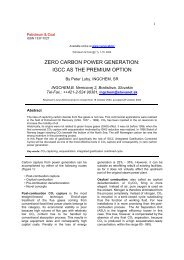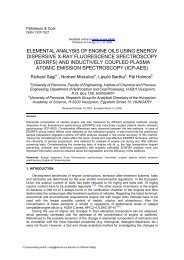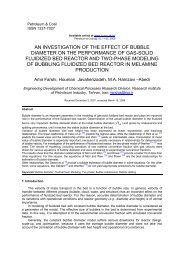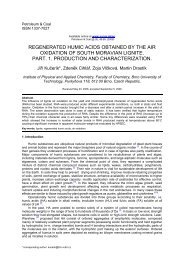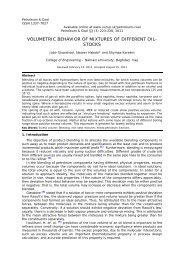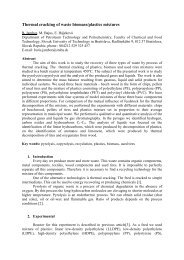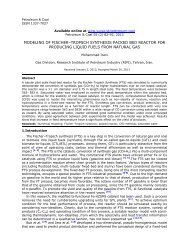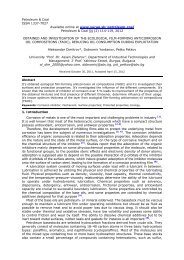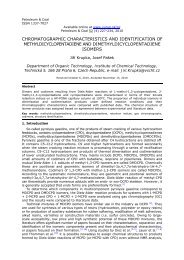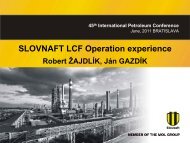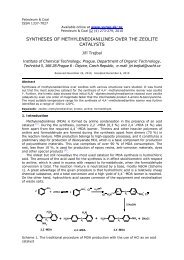Studying the Distillation Method in Converting
Studying the Distillation Method in Converting
Studying the Distillation Method in Converting
- No tags were found...
Create successful ePaper yourself
Turn your PDF publications into a flip-book with our unique Google optimized e-Paper software.
Peet troollleeuum & Cooaal llIISSN 1337-7027Available onl<strong>in</strong>e at www.vurup.sk/pcPetroleum & Coal 48 (2), 47-52, 2006STUDYING OF THE EFFECTIVE PARAMETERS ONENHANCED HEAVY OIL RECOVERY BY STEAM INJECTIONM. Monavarian and Kh.MohamadbeigyResearch Institute of Petroleum Industry – Tehran – Iran – P.O.Box 18745mohamadbeigy@ ripi.irReceived September 22, 2005; received <strong>in</strong> revised form March 20, 2006, accepted June 24, 2006Abstract:High viscosity of some crude oil makes difficult to recover with primary or secondary production methods.Therefore, <strong>the</strong>rmal oil recovery techniques are recommended for <strong>the</strong> Enhanced Oil Recovery (EOR) of heavy oil.In this experimental study, steam <strong>in</strong>jection was used to <strong>in</strong>vestigate <strong>the</strong> effectiveness parameters on heavy oilproduction rate. The result is shown that, by <strong>in</strong>creas<strong>in</strong>g pressure, steam reaches <strong>the</strong> breakthrough po<strong>in</strong>t sooner,but recovery decreases. If <strong>the</strong> oils are a little different <strong>in</strong> viscosity, recovery <strong>in</strong> <strong>the</strong> light oil is more than that <strong>in</strong>heavy oil. Also <strong>in</strong> <strong>the</strong> highly viscous oils and light oils, recovery <strong>in</strong> <strong>the</strong> heavy oil is much higher than <strong>in</strong> light oil.Keywords: heavy oil, steam <strong>in</strong>jection, enhanced oil recovery1. Theoretical backgroundHeavy oils (API gravities from 10 to 20 degrees) have high viscosity and do not flow readily <strong>in</strong>conventional wells. Steam <strong>in</strong>jection and steam flood are often used to produce heavy oil. Steam<strong>in</strong>jection uses a well to <strong>in</strong>ject steam <strong>in</strong>to <strong>the</strong> heavy oil reservoir for a period of time such as two weeks.The steam heats up <strong>the</strong> heavy oil and makes it fluid. The same well is <strong>the</strong>n used to pump <strong>the</strong> heatedheavy oil for a similar period of time. Steam <strong>in</strong>jection and pump<strong>in</strong>g are alternated <strong>in</strong> this technique,called <strong>the</strong> huff and puff method. A steam flood <strong>in</strong>volves <strong>in</strong>jection wells that pump steam <strong>in</strong>to <strong>the</strong> heavyoil reservoir. The pressure of <strong>the</strong> steam forces <strong>the</strong> heated heavy oil to a produc<strong>in</strong>g well between <strong>the</strong><strong>in</strong>jection wells [1,2] .Steam <strong>in</strong>jection is <strong>the</strong> most advanced and most widely used EOR process. There are twoversions of <strong>the</strong> process: cyclic steam <strong>in</strong>jection and steam drive. In <strong>the</strong> first, high-pressure steam orsteam registration and hot water is <strong>in</strong>jected <strong>in</strong>to a well for a period of days or weeks. The <strong>in</strong>jection isstopped and <strong>the</strong> reservoir is allowed to “soak.” After a few days or weeks, <strong>the</strong> well is allowed tobackflow to <strong>the</strong> surface. Pressure <strong>in</strong> <strong>the</strong> produc<strong>in</strong>g well is allowed to decrease and some of <strong>the</strong> waterthat condensed from steam dur<strong>in</strong>g <strong>in</strong>jection or that was <strong>in</strong>jected as hot water <strong>the</strong>n vaporizes anddrives heated oil toward <strong>the</strong> produc<strong>in</strong>g well. When oil production has decl<strong>in</strong>ed appreciably, <strong>the</strong>process is repeated. Because of its cyclic nature, this process is occasionally referred to as <strong>the</strong> “huffand puff” method.The second method, steam drive or steam flood<strong>in</strong>g, <strong>in</strong>volves cont<strong>in</strong>uous <strong>in</strong>jection of steam orsteam and hot water <strong>in</strong> much <strong>the</strong> same way that water is <strong>in</strong>jected <strong>in</strong> water flood<strong>in</strong>g. A reservoir or aportion <strong>the</strong>reof is developed with <strong>in</strong>terlock<strong>in</strong>g patterns of <strong>in</strong>jection and production wells. Dur<strong>in</strong>g thisprocess, a series of zones develop as <strong>the</strong> fluids move from <strong>in</strong>jection well to produc<strong>in</strong>g well. Nearest<strong>the</strong> <strong>in</strong>jection well is a steam zone, ahead of this is a zone of steam condensate (water), and <strong>in</strong> front of<strong>the</strong> condensed water is a band or region of oil be<strong>in</strong>g moved by <strong>the</strong> water. The steam and hot waterzone toge<strong>the</strong>r remove <strong>the</strong> oil and force it ahead of <strong>the</strong> water. Cyclic steam <strong>in</strong>jection is usuallyattempted <strong>in</strong> a reservoir before a full-scale steam drive is <strong>in</strong>itiated, partially as a means of determ<strong>in</strong><strong>in</strong>g<strong>the</strong> technical feasibility of <strong>the</strong> process for a particular reservoir and partly to improve <strong>the</strong> efficiency of<strong>the</strong> subsequent steam drive. A steam drive, where applicable, will recover more oil than cyclic steam<strong>in</strong>jection and is one of <strong>the</strong> five EOR methods used <strong>in</strong> this study of <strong>the</strong> national potential for EORprocesses [3-6] .
M. Monavarian and Kh. Mohamadbeigy/Petroleum & Coal 48(2) 47-52 (2006) 482. Set up and Experimental <strong>Method</strong>In this study, <strong>the</strong> reservoir condition is simulated based on a sand packed model ( ϕ (sandporosity) = 0.23, K= 300 md). Figure (1) is illustrated <strong>the</strong> experimental set-up, that <strong>in</strong>cluded:1. A cyl<strong>in</strong>der with a height of 1.5m and diameter of 4 <strong>in</strong>, filled with sifted sand2. A centrifuge pump, which <strong>in</strong>jects cold water <strong>in</strong>to <strong>the</strong> system3. Steam <strong>in</strong>jection apparatusOilTo VacuumCrude oil vesselVacuum vesselOil outletSteamPI PI TI PI TISeparatorSand Packed CoreCondensateFigure (1): Steam <strong>in</strong>jection set upWater outletThe first part of <strong>the</strong> device was connected to <strong>the</strong> steam <strong>in</strong>ject<strong>in</strong>g valve by rubber tub<strong>in</strong>g andsteam was <strong>in</strong>jected with desired pressures. A pressure gauge and a <strong>the</strong>rmometer display <strong>the</strong> <strong>in</strong>putsteam pressure. There was also a valve through which <strong>the</strong> oil was fed <strong>in</strong>to <strong>the</strong> system until it wascompletely saturated. F<strong>in</strong>ally a vacuum system was used to provide low pressures and a vessel forevacuat<strong>in</strong>g <strong>the</strong> oil and water. Table (I) is shown samples specification and experimental conditionsused <strong>in</strong> this work.ExperimentTypeSteam InjectionWater Flood<strong>in</strong>gTable (I): Experimental conditions <strong>in</strong> laboratory modelSampleNo. 1 (API =13, Viscosity =1000 cp, Density = 980kg/m3)No. 2 (API =17, Viscosity =700 cp, Density = 950kg/m3)Heavy Oil(API =13, Viscosity =1000 cp, Density = 980kg/m3)RemarksPressure Steam(3.2, 1.65 and 1.2Barg)T (°C) =14,Flow rate = 6 cc/sSteam <strong>in</strong>jection was carried out <strong>in</strong> 3.2, 1.65 and 1.2 bar g pressures. The results obta<strong>in</strong>ed from steam<strong>in</strong>jection recovery were compared with those from water <strong>in</strong>jection under <strong>the</strong> same conditions. Theamount of produced fluid was recorded <strong>in</strong> period times and it was repeated until <strong>the</strong> end of <strong>the</strong> testwhen steam came out of <strong>the</strong> tube. This po<strong>in</strong>t is called <strong>the</strong> breakthrough po<strong>in</strong>t. Record<strong>in</strong>g wascont<strong>in</strong>ued for a while after <strong>the</strong> breakthrough po<strong>in</strong>t and <strong>the</strong> level was recorded. After f<strong>in</strong>ish<strong>in</strong>g eachtest, <strong>the</strong> system was saturated with oil for <strong>the</strong> next test and it was reached room temperature. It wasimportant that <strong>the</strong> system be completely <strong>in</strong>sulated. To saturate, Oil was poured from <strong>the</strong> end of <strong>the</strong>tube <strong>in</strong>to <strong>the</strong> system through a case with a faucet. On <strong>the</strong> o<strong>the</strong>r side, <strong>in</strong> <strong>the</strong> end part of <strong>the</strong> system, <strong>the</strong>system was connected to a vacuumed case by rubber tub<strong>in</strong>g and oil slowly poured through <strong>in</strong>to <strong>the</strong>tube.3. Discussion and ResultsAt first step, experiments are done on sample No.1 (API= 13) and steam is <strong>in</strong>jected to <strong>the</strong> setup forsystem <strong>in</strong>vestigation.
M. Monavarian and Kh. Mohamadbeigy/Petroleum & Coal 48(2) 47-52 (2006) 49The result is showed <strong>in</strong> figure (2). After a few m<strong>in</strong>utes, produced fluid (oil and water) is exited and<strong>the</strong> rate of produced fluid is <strong>in</strong>creased until steam reaches <strong>the</strong> end of <strong>the</strong> core (breakthrough).Figure (2): Produced Fluid versus Time (Sample No. =1)Figure 2 is shown produced oil curve versus time, it <strong>in</strong>dicated <strong>in</strong> 3.2 bar g pressure steam, until 15m<strong>in</strong>utes <strong>the</strong> oil production was zero. After 20 m<strong>in</strong>utes, oil production <strong>in</strong>creased until 180 m<strong>in</strong>utes from<strong>the</strong> beg<strong>in</strong>n<strong>in</strong>g of <strong>the</strong> test, oil level became more than water level because <strong>the</strong> soak of temperature<strong>in</strong>creased dur<strong>in</strong>g <strong>the</strong> test. From this figure, it is observed that <strong>in</strong> <strong>the</strong> first times, <strong>the</strong> oil rate is little andafter a few m<strong>in</strong>utes, it <strong>in</strong>creases. After 187 m<strong>in</strong>utes, steam reached <strong>the</strong> breakthrough po<strong>in</strong>t. After <strong>the</strong>breakthrough po<strong>in</strong>t, oil production was approximately constant.This experiment is done on sample 2; <strong>the</strong> same results can be seen (see fig 3,4) and by pressuredecrease, recovery <strong>in</strong>creases and <strong>the</strong> production of water decreases and steam reaches <strong>the</strong>breakthrough po<strong>in</strong>t later and oil specification is lighter and fluid produced time decreased.With comparison of figures 2 and 4, it is obta<strong>in</strong>ed; Steam reaches to <strong>the</strong> breakthrough po<strong>in</strong>t laterby decreas<strong>in</strong>g API of heavy oil and steam reaches <strong>the</strong> breakthrough po<strong>in</strong>t later by decreas<strong>in</strong>gpressure but production beg<strong>in</strong>s sooner and with a higher amount. On <strong>the</strong> o<strong>the</strong>r hand, <strong>the</strong> mount ofproduced water is less than <strong>in</strong> previous cases because heat loss is less.Fluid production and recovery is a little more than that at <strong>the</strong> same pressure on <strong>the</strong> sample 1. Itcan be concluded that steam <strong>in</strong> <strong>the</strong> 3.2 bar g reaches <strong>the</strong> po<strong>in</strong>t of breakthrough sooner than <strong>the</strong> o<strong>the</strong>rpressures. This means that level curve has more gradient as compared with time. On <strong>the</strong> o<strong>the</strong>r hand,recovery <strong>in</strong> 3.2 bar g was less than those at 1.65 and 1.2 bar g because as pressure goes up, <strong>the</strong>temperature of <strong>in</strong>jection <strong>in</strong>creases too.Figure (3): Produced Oil versus Time (Sample No. 1)
M. Monavarian and Kh. Mohamadbeigy/Petroleum & Coal 48(2) 47-52 (2006) 50Figure (4): Produced Fluid versus Time (Sample No. =2)Figure (5): Produced Oil versus Time (Sample No. =2)Figure (6): Breakthrough po<strong>in</strong>t curve (Sample No. =1)The recovery curve as compared with produced fluid <strong>the</strong> gradient of curve <strong>in</strong> 1.2 bar g was morethan those at 1.65 and 3.2 bar g and <strong>the</strong> level of water was less than 3.2 and 1.65 bar g , <strong>the</strong>refore aspressure goes up steam can reach <strong>the</strong> po<strong>in</strong>t of breakthrough sooner but <strong>the</strong> recovery decreases.Because; as <strong>the</strong> steam pressure <strong>in</strong>crease, evaporation heat decrease, <strong>the</strong>refore required steam forheat<strong>in</strong>g is <strong>in</strong>creased.
M. Monavarian and Kh. Mohamadbeigy/Petroleum & Coal 48(2) 47-52 (2006) 51Figure (7): Breakthrough po<strong>in</strong>t curve (Sample No. =2)Figure 8 <strong>in</strong>dicates water flood<strong>in</strong>g <strong>in</strong> sand packed core. This figure showed that recovery <strong>in</strong> waterflood<strong>in</strong>g was less than <strong>in</strong> steam <strong>in</strong>jection because f<strong>in</strong>ger<strong>in</strong>g effect has occurred and consequently <strong>the</strong>vertical sweep efficiency and oil production decreased.4. ConclusionFigure (8): Produced Oil versus Time cold water <strong>in</strong>jectionThe result shown that, breakthrough po<strong>in</strong>t arises sooner <strong>in</strong> higher pressure (3.2 bar g ). But recovery<strong>in</strong> 3.2 bar g is less than <strong>in</strong> 1.2 and 1.65 bar g because as pressure <strong>in</strong>creases, <strong>the</strong> temperature of<strong>in</strong>jection <strong>in</strong>creases too.On <strong>the</strong> o<strong>the</strong>r hand, <strong>the</strong> temperature of condensate <strong>in</strong>creases as well. This means that <strong>the</strong> heatneeded for evaporation decreases and <strong>the</strong> amount of steam needed for heat<strong>in</strong>g <strong>the</strong> tank <strong>in</strong>creases. Itis observed that <strong>in</strong> <strong>the</strong> recovery curve as compared with produced fluid <strong>the</strong> gradient of curve <strong>in</strong> 1.2bar g is more than those <strong>in</strong> 3.2 and 1.65 bar g . The level of water is less than 3.2 and 1.65 bar g , so itcan be conclude that as pressure goes up, steam can reach <strong>the</strong> po<strong>in</strong>t of breakthrough sooner and <strong>the</strong>recovery decreases as well. It is seen that cool water reaches <strong>the</strong> po<strong>in</strong>t of breakthrough sooner thansteam and thus <strong>the</strong> recovery of cool water is lower than that of steam. In this test, f<strong>in</strong>ger<strong>in</strong>g hasμoccurred becausew
M. Monavarian and Kh. Mohamadbeigy/Petroleum & Coal 48(2) 47-52 (2006) 52References[1] Chil<strong>in</strong>garian.G.V., Robertson.J.O., Kumar.S., “Surface operations <strong>in</strong> petroleumproduction”, Elsevier Science Publishers, New York.,PP:221-276, 1989.[2] Xiancong.W., Jun.J., Haop<strong>in</strong>g.W., “ Recovery of bitumen by <strong>in</strong>jection of steam withsurfactant”, Petroleum Science and Technology, v 23, n 9-10, p: 1059-1073,September/October, 2005.[3] Butler, R.M. “Thermal Recovery of Oil and Bitumen”. Englewood Cliffs, N.J. PrenticeHall, PP: 285-359, 1991.[4] Zhao.L., Nasr.T.N., Huang.H.., “Steam alternat<strong>in</strong>g solvent process: Lab test andsimulation”, Petroleum Technology, v 44, n 9, PP: 37-42, September, 2005.[5] Willman, B.T., Valleroy, V.V., Runberg, G.W., “Laboratory Studies of Oil Recovery bySteam Injection”, Petroleum Technology., p: 681- 690. July.1961.[6] US Patent No. 4,969,520, “Steam <strong>in</strong>jection process for recover<strong>in</strong>g heavy oil”,Raymond.J. , Reed.Jr. , Thomas.G., Nov.1990.



